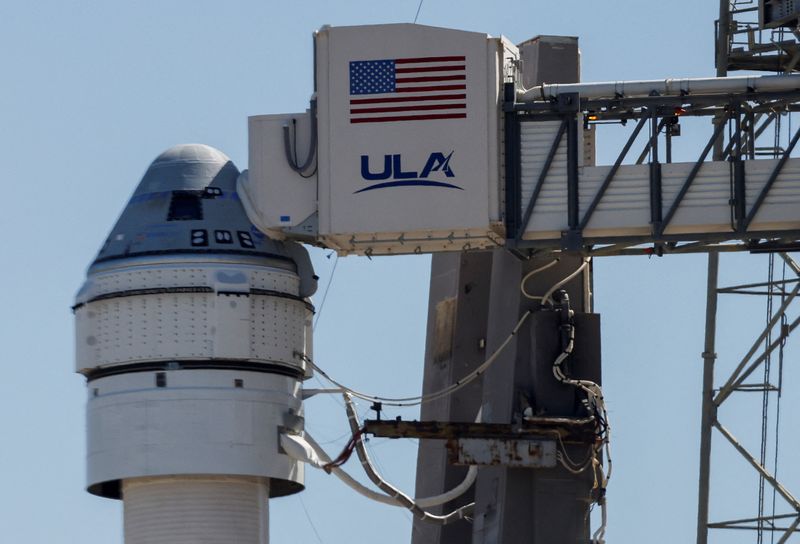By Joey Roulette
WASHINGTON (Reuters) - Boeing (NYSE:BA) and NASA quelled two technical issues on the company's Starliner spacecraft, including a "design vulnerability" requiring a temporary workaround, to get the capsule back on track for its first mission carrying two astronauts to space, officials said on Friday.
Starliner's debut crewed mission, a high-stakes test now planned for June 1, was derailed earlier this month by a small helium leak detected in its propulsion system hours before it was due to lift off from Florida. Over two weeks of extra scrutiny found that the leak poses no major risk to the astronauts, officials said.
"This is really not a safety of flight issue for ourselves, and we believe that we have a well-understood condition that we can manage," Boeing's Starliner boss Mark Nappi told reporters during a news conference.
Starliner's long-delayed first crewed flight, with NASA astronauts Suni Williams and Butch Wilmore on board, is a final test mission before NASA can certify the spacecraft for routine astronaut trips to and from the International Space Station. It would become the second U.S. crew capsule alongside SpaceX's Crew Dragon, which started flying humans in 2020.
Boeing and NASA's probe of the helium leak led engineers to uncover an additional issue in Starliner's propulsion system that NASA's commercial crew chief Steve Stich called a "design vulnerability."
Modeling showed that a cascading, but very unlikely, series of issues during a mission could eliminate the capsule's backup thrusters and render it unable to safely return to Earth. A software fix offered a temporary workaround for the mission, but Boeing and NASA will discuss whether a deeper redesign is needed before future flights, officials said.
"It's backed by test data, it's backed by flight data, and the guidance and navigation modeling have reinforced that this technique will work," Nappi said, adding the astronauts had tested the system after the fix.
That broader issue and ad hoc resolution prompted NASA to call for an additional Flight Readiness Review, an extensive, day-long meeting among agency officials, Boeing engineers and independent analysts to justify Starliner is safe for flight.
That meeting is scheduled for Wednesday, three days before Boeing's target launch time on June 1, 12:25 PM ET. If needed Starliner also has opportunities to fly June 2, 5 and 6.
Boeing, which initially attempted to launch Starliner May 6, faces pressure to make one of those early June dates.
Anything later than June 6 could trigger weeks or potentially months of more delays because some perishable items would need to be replaced on Starliner and its Atlas (NYSE:ATCO) 5 rocket, built by the Boeing-Lockheed joint venture United Launch Alliance (ULA).
That would begin to clash with other scheduled priorities ULA has on its launch pad, such as Amazon (NASDAQ:AMZN)'s first launch of its Kuiper satellites and ULA's second flight of its new Vulcan rocket, a long-delayed demonstration that would allow it to start launching Pentagon missions.
Boeing is a longtime NASA contractor that has built modules for the decades-old International Space Station but has never before flown humans into space, a feat that persistent struggles in its Starliner program has made elusive.
Years behind schedule and with $1.5 billion in unplanned development costs, a success with Starliner is badly needed as Boeing reels from unrelenting crises in its aviation business.

Starliner in 2019 failed an attempt to reach the ISS, returning to Earth roughly a week earlier than planned because of dozens of software, technical and management issues that reshaped Boeing's relationship with NASA.
The spacecraft succeeded in a re-do flight in 2022 to the ISS.